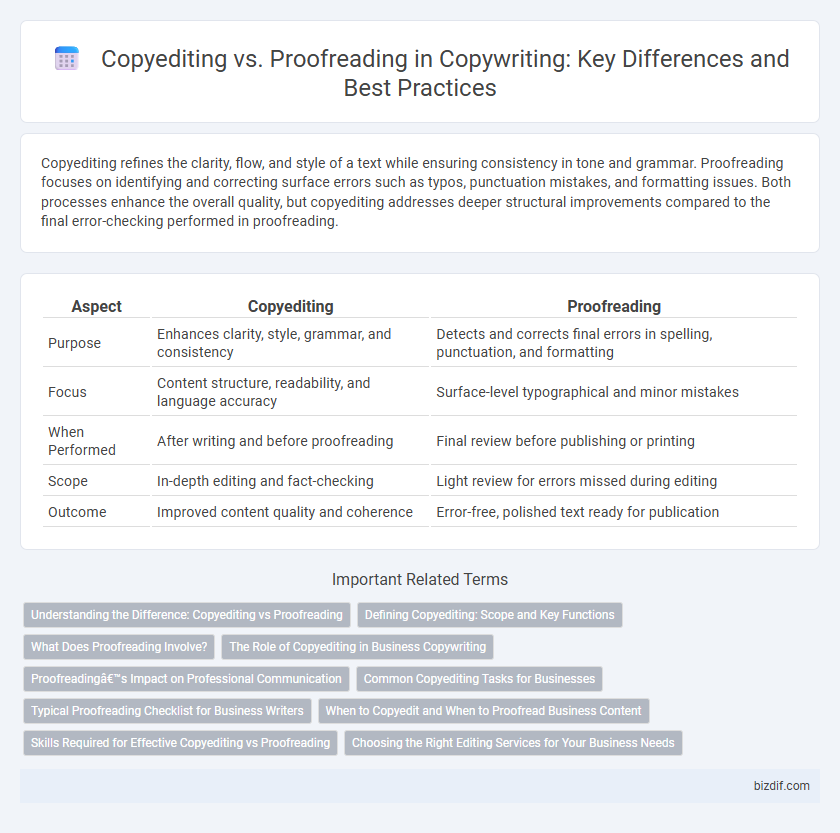Copyediting refines the clarity, flow, and style of a text while ensuring consistency in tone and grammar. Proofreading focuses on identifying and correcting surface errors such as typos, punctuation mistakes, and formatting issues. Both processes enhance the overall quality, but copyediting addresses deeper structural improvements compared to the final error-checking performed in proofreading.
Table of Comparison
| Aspect | Copyediting | Proofreading |
|---|---|---|
| Purpose | Enhances clarity, style, grammar, and consistency | Detects and corrects final errors in spelling, punctuation, and formatting |
| Focus | Content structure, readability, and language accuracy | Surface-level typographical and minor mistakes |
| When Performed | After writing and before proofreading | Final review before publishing or printing |
| Scope | In-depth editing and fact-checking | Light review for errors missed during editing |
| Outcome | Improved content quality and coherence | Error-free, polished text ready for publication |
Understanding the Difference: Copyediting vs Proofreading
Copyediting involves refining content for clarity, consistency, grammar, and style, ensuring the text flows logically and maintains the author's voice. Proofreading is the final quality check that targets surface errors like typos, punctuation mistakes, and formatting issues before publication. Understanding the difference between copyediting and proofreading helps streamline the editing process and improve the overall quality of written material.
Defining Copyediting: Scope and Key Functions
Copyediting encompasses a thorough review of written content to enhance clarity, coherence, and overall quality by addressing grammar, style, tone, and factual accuracy. It involves restructuring sentences, refining word choice, and ensuring consistency throughout the text to align with the intended audience and brand voice. Key functions of copyediting include eliminating redundancies, correcting syntax errors, and verifying factual details to produce polished, publication-ready material.
What Does Proofreading Involve?
Proofreading involves carefully reviewing a final draft to identify and correct surface errors such as typos, spelling mistakes, punctuation errors, and formatting inconsistencies. It ensures that the text is polished, free of distracting errors, and ready for publication or distribution. Proofreading is the last step in the editorial process, focusing on accuracy rather than content or style improvements.
The Role of Copyediting in Business Copywriting
Copyediting in business copywriting enhances clarity, consistency, and brand voice while ensuring error-free content that resonates with target audiences. It involves refining sentence structure, improving word choice, and maintaining a cohesive tone aligned with marketing goals. This process positions copyediting as a crucial step for maximizing the impact and professionalism of business communications.
Proofreading’s Impact on Professional Communication
Proofreading ensures that professional communication is free from spelling, grammar, and punctuation errors, which enhances clarity and credibility. Accurate proofreading reduces misunderstandings and misinterpretations, fostering trust between businesses and their audiences. By delivering polished content, proofreading supports a strong brand image and effective message delivery.
Common Copyediting Tasks for Businesses
Common copyediting tasks for businesses involve refining text for clarity, consistency, and style while ensuring adherence to brand voice and industry standards. This includes correcting grammar, punctuation, spelling errors, improving sentence structure, and fact-checking to maintain accuracy. Effective copyediting enhances readability and accuracy, ultimately supporting better communication with target audiences and strengthening brand reputation.
Typical Proofreading Checklist for Business Writers
A typical proofreading checklist for business writers includes verifying spelling, punctuation, and grammar to ensure error-free communication. Attention to consistency in formatting, such as font style, heading hierarchy, and alignment, strengthens the professional appearance of documents. Checking for proper factual accuracy, including names, dates, and statistics, helps maintain credibility and trust in business writing.
When to Copyedit and When to Proofread Business Content
Copyedit business content when clarity, tone, and style need refinement to ensure brand consistency and effective communication. Proofread final drafts to catch typographical errors, punctuation mistakes, and formatting issues before publishing or distribution. Use copyediting during content development and proofreading as the last quality control step to maintain professional, error-free materials.
Skills Required for Effective Copyediting vs Proofreading
Effective copyediting demands strong language proficiency, attention to contextual detail, and the ability to refine tone, clarity, and flow, ensuring the text aligns with the intended audience and purpose. Proofreading requires keen attention to grammar, punctuation, spelling mistakes, and formatting inconsistencies to ensure error-free final content. Both roles necessitate a meticulous eye, but copyediting involves deeper editorial skills, while proofreading focuses on surface-level accuracy.
Choosing the Right Editing Services for Your Business Needs
Choosing the right editing services for your business depends on understanding the distinct roles of copyediting and proofreading. Copyediting enhances clarity, grammar, and style while ensuring consistency across your content, making it ideal for refining drafts before publication. Proofreading focuses on catching surface errors like typos and formatting issues, serving as the final quality check to ensure polished, professional communication.
Copyediting vs Proofreading Infographic

 bizdif.com
bizdif.com